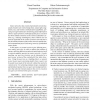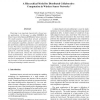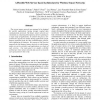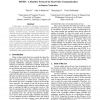P2P
2003
IEEE
14 years 4 months ago
2003
IEEE
Sensor networks, that consist of potentially several thousands of nodes each with sensing (heat, sound, light, magnetism, etc.) and wireless communication capabilities, provide gr...
LCN
2003
IEEE
14 years 4 months ago
2003
IEEE
Sensor networks are designed especially for deployment in adverse and nonaccessible areas without a fixed infrastructure. Therefore, energy conservation plays a crucial role for t...
LCN
2003
IEEE
14 years 4 months ago
2003
IEEE
Sensor networks are meant for sensing and disseminating information about the environment they sense. The criticality of a sensed phenomenon determines it’s importance to the en...
ISCAS
2003
IEEE
14 years 4 months ago
2003
IEEE
Continuing trends in sensor, semiconductor and communication systems technology (smaller, faster, cheaper) make feasible very dense networks of fixed and mobile wireless devices ...
ISADS
2003
IEEE
14 years 4 months ago
2003
IEEE
In the future, intelligent sensors will connected through networks, each node have its own autonomy, heterogeneity, and under dynamic environments. We call these systems as a Hete...
IPPS
2003
IEEE
14 years 4 months ago
2003
IEEE
Clustering is an important characteristic of most sensor applications. In this paper we define COSMOS, the Cluster-based, heterOgeneouS MOdel for Sensor networks. The model assum...
INFOCOM
2003
IEEE
14 years 4 months ago
2003
IEEE
— We propose a novel approach to reducing energy consumption in sensor networks using a distributed adaptive signal processing framework and efficient algorithm 1 . While the to...
ICDCSW
2003
IEEE
14 years 4 months ago
2003
IEEE
The current sensor networks are assumed to be designed for specific applications, having strongly coupled data communication protocols. The future sensor networks are envisioned a...
ICDCSW
2003
IEEE
14 years 4 months ago
2003
IEEE
Recent advances in wireless sensor networks have led to many new routing protocols specifically designed for sensor networks. Almost all of these routing protocols considered ener...
ICDCS
2003
IEEE
14 years 4 months ago
2003
IEEE
In this paper, we present a real-time communication protocol for sensor networks, called SPEED. The protocol provides three types of real-time communication services, namely, real...




